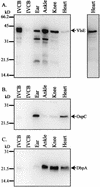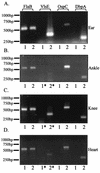Antigenic composition of Borrelia burgdorferi during infection of SCID mice
- PMID: 12761126
- PMCID: PMC155750
- DOI: 10.1128/IAI.71.6.3419-3428.2003
Antigenic composition of Borrelia burgdorferi during infection of SCID mice
Abstract
The general concept that during infection of mice the Borrelia burgdorferi surface protein composition differs profoundly from that of tick-borne or in vitro-cultivated spirochetes is well established. Specific knowledge concerning the differences is limited because the small numbers of spirochetes present in tissue have not been amenable to direct compositional analysis. In this report we describe novel means for studying the antigenic composition of host-adapted Borrelia (HAB). The detergent Triton X-114 was used to extract the detergent-phase HAB proteins from mouse ears, ankles, knees, and hearts. Immunoblot analysis revealed a profile distinct from that of in vitro-cultivated Borrelia (IVCB). OspA and OspB were not found in the tissues of SCID mice 17 days after infection. The amounts of antigenic variation protein VlsE and the relative amounts of its transcripts were markedly increased in ear, ankle, and knee tissues but not in heart tissue. VlsE existed as isoforms having both different unit sizes and discrete lower molecular masses. The hydrophobic smaller forms of VlsE were also found in IVCB. The amounts of the surface protein (OspC) and the decorin binding protein (DbpA) were increased in ear, ankle, knee, and heart tissues, as were the relative amounts of their transcripts. Along with these findings regarding VlsE, OspC, and DbpA, two-dimensional immunoblot analysis with immune sera also revealed additional details of the antigenic composition of HAB extracted from ear, heart, and joint tissues. A variety of novel antigens, including antigens with molecular masses of 65 and 30 kDa, were found to be upregulated in mouse tissues. Extraction of hydrophobic B. burgdorferi antigens from tissue provides a powerful tool for determining the antigenic composition of HAB.
Figures





Similar articles
-
Temporal analysis of the antigenic composition of Borrelia burgdorferi during infection in rabbit skin.Infect Immun. 2004 Sep;72(9):5063-72. doi: 10.1128/IAI.72.9.5063-5072.2004. Infect Immun. 2004. PMID: 15321999 Free PMC article.
-
Detailed analysis of sequence changes occurring during vlsE antigenic variation in the mouse model of Borrelia burgdorferi infection.PLoS Pathog. 2009 Feb;5(2):e1000293. doi: 10.1371/journal.ppat.1000293. Epub 2009 Feb 13. PLoS Pathog. 2009. PMID: 19214205 Free PMC article.
-
Lipoprotein succession in Borrelia burgdorferi: similar but distinct roles for OspC and VlsE at different stages of mammalian infection.Mol Microbiol. 2013 Jul;89(2):216-27. doi: 10.1111/mmi.12271. Epub 2013 Jun 7. Mol Microbiol. 2013. PMID: 23692497 Free PMC article.
-
Changing of the guard: How the Lyme disease spirochete subverts the host immune response.J Biol Chem. 2020 Jan 10;295(2):301-313. doi: 10.1074/jbc.REV119.008583. Epub 2019 Nov 21. J Biol Chem. 2020. PMID: 31753921 Free PMC article. Review.
-
vls Antigenic Variation Systems of Lyme Disease Borrelia: Eluding Host Immunity through both Random, Segmental Gene Conversion and Framework Heterogeneity.Microbiol Spectr. 2014 Dec;2(6):10.1128/microbiolspec.MDNA3-0038-2014. doi: 10.1128/microbiolspec.MDNA3-0038-2014. Microbiol Spectr. 2014. PMID: 26104445 Free PMC article. Review.
Cited by
-
RNA-Seq-based analysis of changes in Borrelia burgdorferi gene expression linked to pathogenicity.Parasit Vectors. 2015 Mar 13;8:155. doi: 10.1186/s13071-014-0623-2. Parasit Vectors. 2015. PMID: 25886272 Free PMC article.
-
Effects of vlsE complementation on the infectivity of Borrelia burgdorferi lacking the linear plasmid lp28-1.Infect Immun. 2004 Nov;72(11):6577-85. doi: 10.1128/IAI.72.11.6577-6585.2004. Infect Immun. 2004. PMID: 15501789 Free PMC article.
-
Diagnosis of lyme borreliosis.Clin Microbiol Rev. 2005 Jul;18(3):484-509. doi: 10.1128/CMR.18.3.484-509.2005. Clin Microbiol Rev. 2005. PMID: 16020686 Free PMC article. Review.
-
The failure of immune response evasion by linear plasmid 28-1-deficient Borrelia burgdorferi is attributable to persistent expression of an outer surface protein.Infect Immun. 2008 Sep;76(9):3984-91. doi: 10.1128/IAI.00387-08. Epub 2008 Jul 14. Infect Immun. 2008. PMID: 18625742 Free PMC article.
-
Variable VlsE is critical for host reinfection by the Lyme disease spirochete.PLoS One. 2013 Apr 8;8(4):e61226. doi: 10.1371/journal.pone.0061226. Print 2013. PLoS One. 2013. PMID: 23593438 Free PMC article.
References
-
- Akins, D. R., S. F. Porcella, T. G. Popova, D. Shevchenko, S. I. Baker, M. Li, M. V. Norgard, and J. D. Radolf. 1995. Evidence for in vivo but not in vitro expression of a Borrelia burgdorferi outer surface protein F (OspF) homologue. Mol. Microbiol. 18:507-520. - PubMed
Publication types
MeSH terms
Substances
Grants and funding
LinkOut - more resources
Full Text Sources
Other Literature Sources
Medical
Miscellaneous

